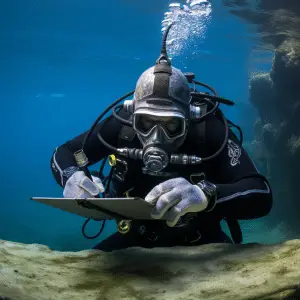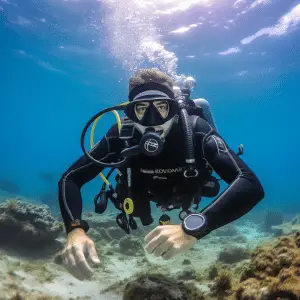Safe and Fun Dive, to have a safe and fun dive requires serious thought and detail. Preparing yourself both mentally and physically, plus taking into account factors which may affect your experience are key. Heed a few guidelines and you’ll have an unforgettable, trouble-free journey below the sea.
- First, consider your abilities and fitness. Safe and Fun Dive will help you decide what type of sites suit you. Talk to experienced divers or instructors for tips, based on their expertise.
- Next, look into diving spots that interest you and match your level. Gain information on the waters, marine life, currents, visibility and any potential risks. Being aware of the area allows you to make decisions about safety and equipment.
- Choose a trustworthy dive operator or guide who follows safety protocols. Look out for certifications from organisations like PADI or SSI. The operator should give a safety briefing before each dive, provide well-maintained gear and have emergency plans.
- Communication within the group is essential for safety underwater. Agree on signals and hand gestures that everyone knows, in case verbal communication is not possible due to being submerged. Check in with one another during the dive.
- Follow the correct procedures – pre-dive checks on equipment, monitoring air supply. Plan dives with conservative bottom times for unexpected incidents.
By prepping well, researching, selecting a reliable operator and communicating with your group, you can enjoy and be safe underwater. Time and effort spent on preparation will guarantee lifelong memories. Ready to explore the underwater world? Dive in and have a fantastic experience!
Research and preparation

When plotting a safe and fun dive outing, research and prep are key. Here are some aspects to keep in mind:
- Dive Sites: Pick spots known for good safety and diverse marine life.
- Weather: Check the forecast ahead of time to avoid bad dive conditions.
- Equipment: Make sure each piece is working correctly and meets safety standards.
- Dive Plan: Make a plan that includes depth and time limits and emergency procedures.
- Safety Tips: Learn the local regulations, possible hazards, and emergency contacts.
Research dive sites you’re exploring. Factors like visibility, water temp, currents, and marine life should be taken into consideration.
Check the weather before heading out – bad weather can be hazardous and reduce visibility.
Inspect all diving equipment before the trip – regulators, masks, fins, BCDs, tanks, weights, and more.
Create a detailed dive plan with depth and time limits, plus emergency procedures.
Learn the local guidelines and restrictions, and any potential hazards (like strong currents or animal behaviors).
Remember: research and prep are essential for a safe dive excursion! (PADI – Professional Association of Diving Instructors).
Choosing the right equipment
When diving, there are certain pieces of equipment you’ll need: a dive mask for clear vision, a snorkel for breathing on the surface, a wetsuit for warmth and protection, a BCD for buoyancy control, a regulator for air supply, a dive computer for tracking, fins for maneuverability, and a weight belt for balance.
To ensure a great experience, consider these unique details when choosing equipment: silicone skirts on masks for a better seal, wetsuits that fit snugly but still allow flexibility, and BCDs with integrated weight pockets.
Silicone skirts provide a comfortable fit and prevent leaks, wetsuits keep you warm, and integrated weight pockets eliminate the need for a separate weight belt.
Prioritize quality and fit for a safe and enjoyable dive.
Selecting a certified dive operator
Check certifications! Ensure the dive operator has valid certifications from recognized organizations like PADI or SSI. Research reviews and feedback to assess the operator’s reputation. Make sure they follow strict safety protocols, have experienced instructors, and use quality equipment.
Moreover, think about accessibility, transportation, and amenities. All of these can improve your experience. Plus, before booking, ask about underwater photography or videography. Capture your memories with ease!
Creating a dive plan
- Research the Dive Site: Before jumping into unknown waters, collect info about the dive spot. Know about the depth, currents, marine life, and any possible risks. This will help you plan your dive and make good decisions during it.
- Evaluate Yourself: Safe and Fun Dive is key to be honest with your own skills and limitations as a diver. Think about experience level, certifications, fitness, and comfort in various diving conditions. This will decide the right depth and difficulty for your dive.
- Plan Your Dive Profile: After researching the dive site and assessing yourself, create a dive profile. Pick the maximum depth you’ll reach, dive duration, ascend points, safety stops, and any special equipment or techniques. Have a back-up plan in case of something unexpected.
- Before heading out for your dive, check the weather.
- Lastly, never overlook the importance of keeping your gear in good shape and getting updated training to stay safe underwater.
A fact: DAN (Divers Alert Network) claims that inadequate pre-dive planning causes 13% of scuba diving accidents.
Safety procedures and emergency preparedness
Safety and emergency preparedness are essential for a successful dive. Follow these safety measures for a safe and enjoyable dive:
- Check your gear – mask, regulator, BCD, and other equipment – before diving.
- Plan your dive and stay within the safe limits.
- Dive with a buddy and use hand signals to communicate underwater.
- Know basic first aid and CPR techniques.
- Always carry a first aid kit.
- Familiarize yourself with the location’s safety procedures.
- The NAUI suggests divers to maintain 6 feet distance from marine life to prevent disturbance or harm.
Dive buddy system and communication
The Dive Buddy System and communication are key for a safe and enjoyable dive excursion. Working together brings the experience up a notch and also keeps you safe!
- Communicating effectively with your buddy is vital – use hand signals, underwater slates, or underwater communication equipment.
- Checking in with your dive buddy during the dive keeps awareness up and helps you take action in case of an emergency or changes in plan.
- Keep an eye on your buddy’s air supply, depth, and overall well-being. This gives you extra safety, as you can help each other if needed.
- Set a meeting point underwater in case of separation – this ensures you can communicate effectively even if you get split up.
Open and honest communication builds trust and helps you understand each other’s preferences and limitations – leading to better coordination during the dive.
Fun fact: Jacques Cousteau, the French oceanographer, made the Dive Buddy System popular!
Post-dive debriefing and analysis

| Element | Description |
| Depth | Check if the maximum depth reached matches the planned one. |
| Dive Time | Analyze the duration in relation to air consumption, decompression limits, and dive plan. |
| Decompression Stops | Examine the effectiveness of stops taken during ascent to manage nitrogen. |
| Buddy System | Assess communication, cooperation, and support to ensure safety. |
Bring up any challenges or unusual situations during the dive. This may include equipment breakdowns, bad weather, or interactions with marine life. Sharing these experiences can give valuable lessons.
To have better dives, look at these tips:
- Pre-dive planning: Ensure all necessary equipment is functioning and create a detailed plan accounting for possible risks.
- Better communication: Enhance communication between buddies with underwater hand signals or advanced tech.
- Training and education: Take part in regular training sessions and workshops to improve skills and stay up-to-date with safety protocols.
- Physical fitness: Exercise and maintain health to boost diving performance and endurance.
If these suggestions are discussed in post-dive debriefings, divers can enhance their dive experiences, reduce risks, and make underwater time more enjoyable.
Conclusion
Diving excursions can be exciting and risky. So, plan carefully for a safe and exciting experience. Follow these steps:
- Research the dive site first.
- Make sure it matches your skill level.
- Gather all necessary gear.
- Perform safety checks.
- Dive with a certified professional who knows the area.
- Follow proper diving procedures.
- Communicate well with your partner.
Don’t miss out on the underwater wonders. But, keep safety as the top priority.
Frequently Asked Questions
Q1: How do I choose a reputable dive operator for a safe and enjoyable dive excursion?
A1: To choose a reputable dive operator, research their credentials, certifications, and reviews. Look for operators affiliated with recognized diving organizations such as PADI or NAUI. Additionally, check if they have experienced dive instructors and well-maintained equipment.
Q2: What safety precautions should I consider before going on a dive excursion?
A2: Before diving, ensure you’re in good health and meet the necessary physical requirements. Always perform a pre-dive safety check of your equipment and familiarize yourself with the dive site and local conditions. It’s also crucial to have a dive buddy and communicate effectively underwater.
Q3: What factors should I consider when choosing a dive location for an enjoyable dive excursion?
A3: Consider the experience level of the divers in your group. Choose a location suitable for their skill level, taking into account currents, visibility, and depth. Research the marine life and underwater attractions of the area to ensure it aligns with your interests.
Q4: Is it necessary to have dive insurance for a dive excursion?
A4: While it is not mandatory, having dive insurance is highly recommended. Dive insurance provides coverage for medical emergencies, evacuation, and equipment loss or damage. It offers peace of mind and financial protection in case of unexpected situations.
Q5: What should I pack for a safe and enjoyable dive excursion?
A5: Pack essential items such as your dive certification card, dive logbook, sunscreen, towel, reef-friendly sunscreen, and a first aid kit. Bring spare O-rings, dive computer batteries, and appropriate exposure protection for the dive conditions.
Q6: How can I contribute to the preservation of marine ecosystems during a dive excursion?
A6: Practice responsible diving by never touching or collecting marine life. Avoid stirring up sediments and be cautious with equipment to prevent accidental damage. Choose eco-friendly dive operators that follow sustainable practices and support marine conservation initiatives.
